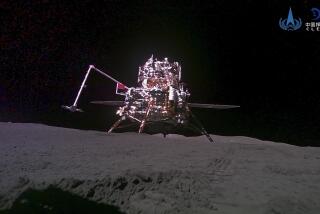Promising the Moon : Lunar Rocks to Be Stars of Program by Former NASA Scientist on Anniversary
- Share via
SAN JUAN CAPISTRANO — In 1969, after global fascination with the first manned lunar landing had cooled, the scientific community still needed a few things explained.
There were questions, legends and myths about the moon that had existed ever since human beings first stood erect and stared in awe at the strange, bright orb hanging in the night sky. How did it get there? Is life on the moon possible? Green cheese or igneous rock?
“There was intense, worldwide interest in the answers held by the moon rocks. It was an extremely exciting time,” said Douglas Nash, 61, who was part of an elite group of NASA scientists assigned to answer age-old scientific questions about the moon. “It’s amazing what heroes our scientists were back then.”
As the 25th anniversary of Neil Armstrong’s historic moon walk is observed around the globe this week, Nash, who now directs the San Juan Institute, a San Juan Capistrano-based think tank, clearly remembers the excitement of waiting for the first crate of moon rocks to be released from quarantine in Houston.
But, he also shakes his head and wonders where in the cosmos has Washington’s support for space exploration gone in recent years.
“You couldn’t convince me 25 years ago that we wouldn’t be back to the moon several times,” Nash said. “The tragedy is that generations of scientists who have all that knowledge from the early Apollo era are about to retire. All that knowledge will be lost.”
With the July 20 anniversary approaching, however, Nash doesn’t have time for bittersweet memories. He is busy preparing a special, free program at the San Juan Institute for Wednesday that will include a display of moon samples from all six Apollo missions. The daylong event will feature lectures from scientists about lunar exploration and a telescopic peek at the moon.
For Nash, the program will be a chance to share his experiences during one of the most historic and significant chapters in space exploration.
“This was a big, big event for us,” he said. “The Apollo 11 mission was the first to bring back lunar samples, and security was tight. Where the rocks were kept we had motion detectors, special locks and closed circuit television.”
The first time Nash took the lunar specimens on a trip, it was like a page from a bad spy novel. “I had escorts,” he said. “The moon rocks were in a suitcase with a chain shackled to my wrist.”
George Mueller, an administrator in NASA’s Manned Space Flight division at the time, said the Apollo 11 launch was the zenith of the country’s technological achievements. He hopes the anniversary will rekindle public interest in the space program, but Mueller wonders if elected officials in Washington would commit more money.
“To me, it’s interesting that we’ve been consigning our space exploration to history before we’ve started,” said the 71-year-old Santa Barbara resident, who is now president of the International Academy of Astronautics. “That first step is a very small first step when you think of space exploration.”
Although much mystery still surrounds the moon, Nash and his fellow NASA scientists solved many moon riddles just a few weeks after getting their hands on the lunar samples.
“A couple of the major questions were answered very quickly, such as how old the moon is,” Nash said. “Through radioactive dating techniques, we determined that the moon is about 4 1/2 billion years old.”
As to where the moon came from, studies of lunar rocks have contributed to the theory that the planet was produced by a collision involving primitive Earth.
When Earth was still a seething mixture of semi-solid rock and magma, Nash said, a very large object, maybe a tenth of the size of the globe, probably crashed into it, ejecting enough material to form the moon.
The moon samples themselves are a mix of orthosite, a type of stone found in the Earth’s mantle, and basaltic rock, a volcanic material similar to that commonly seen in Hawaii and Iceland.
One major difference, though, between Earth and moon rock is that, unlike their terrane counterparts, moon stones are completely devoid of water.
“The moon samples were found to be degassed, missing all volatile material such as water,” Nash said. “It probably happened during the impact that formed the moon.”
As a young scientist working for the Jet Propulsion Laboratory in Pasadena, Nash submitted a proposal to NASA along with hundreds of other researchers in hopes of being considered for the moon project.
To his delight, NASA chose him to be one of about 100 scientists assigned to the high profile Apollo 11 program. His project: Find out why the moon appears so luminescent, despite studies indicating that the earthly satellite is basically a dark object.
Nash soon found out that billions of years of bombardment by microscopic meteorites had caused rock on the moon’s surface to vitrify. The heat caused by innumerable meteor impacts melted the stone over time, turning it glassy and highly reflective.
“We saw that the rocks had little ‘zap’ pits in them,” he said. “It was the first direct evidence of micrometeor impacts. Immense heat energy was caused by these impacts because these tiny meteors, which would normally burn up in our atmosphere, were landing at extremely high velocities of 10 to 20 kilometers per second.”
Twenty-five years after being plucked from the lunar surface, the moon rocks are still helping Nash understand the cosmos with the help of new technology that was unavailable during the height of the Apollo program. One of them is infrared testing to determine what elements a rock is composed of.
“It will help us map the moon’s surface in more detail than ever before,” Nash said. “This is important because more than 95% of the moon’s surface is unexplored.”






